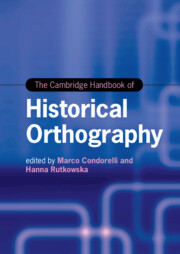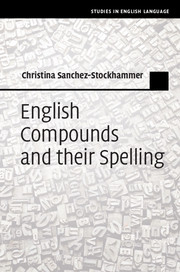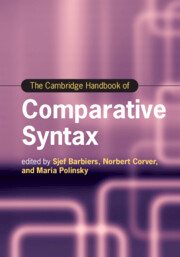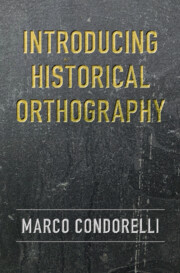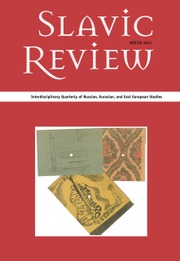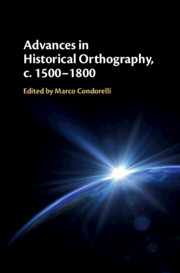The Cambridge Handbook of Historical Orthography
The study of orthography (spelling and writing systems), and its development over the history of language, is central to many areas of linguistic enquiry, offering insight into syntactic and morphological structures, phonology, typology, historical linguistics, literacy and reading, and the social and cultural context of language use. With contributions from a global team of scholars, this Handbook provides the first comprehensive overview of this rapidly developing field, tracing the development of historical orthography, with special emphasis on the last and present centuries. Chapters are split into five key thematic areas, with a focus throughout on the interplay between theory and practice. It also explores the methods used in studying historical orthography, and the principles involved in the development of a spelling system. Providing a critical assessment of the state of the art in the field, it is essential reading for anyone with an interest in writing systems and historical linguistics.
- Provides a comprehensive overview of all the key themes and issues in the rapidly developing field of historical orthography
- Takes an interdisciplinary approach and establishes links between orthography and phonology, morphology, syntax, lexicography, as well as the semantics and pragmatics of language
- Written in an easy-to-read style, making it accessible to scholars and students in other fields of linguistics
Reviews & endorsements
'In this Handbook, the reader will find a wide variety of detailed and sometimes unexpected orthographic topics, ranging from linguistics to social/political factors to typography and beyond, all of which have historical reflexes which may persist to the present day. Principles are elucidated, but also with plentiful examples from ancient Western and non-Western orthographies.' Michael Cahill, Orthography Services Coordinator, SIL International
'There is no orthography without history because the very purpose of orthography is to arrest change. This handbook addresses a wide range of well-chosen research topics that make this general insight real. Historical questions about norm-setting authorities are dealt with as well as theoretical and methodological intricacies of how to study orthographies in history, and the categorization and typology of orthographies and writing systems. In all, a handbook worthy of that name.' Florian Coulmas, Senior Professor of Japanese Society and Sociolinguistics, University of Duisburg-Essen
'This much-needed volume is the first to provide a comprehensive overview of the relatively new discipline of historical orthography. It combines complex theoretical, methodological, and case-based studies with essential information on the context in which the discipline has developed. It will act as the go-to reference text for work in this area.' Damien Mooney, Senior Lecturer in French Linguistics and Language Change, University of Bristol
'This book is impressive both in its breadth of coverage and in the depth of its discussions of the topics included. It is certain to be an important resource for students as well as advanced researchers within this field.' Mark Sebba, Reader Emeritus in Sociolinguistics & Language Contact, Lancaster University
'This Handbook is an excellent resource that fills a gap in the literature on writing systems research. It provides a range of chapters that will be of interest to scholars and students of writing systems and orthography, including key background information and innovative advances in the field.' Christine Schreyer, Associate Professor of Anthropology, University of British Columbia
Product details
September 2023Adobe eBook Reader
9781108802475
0 pages
This ISBN is for an eBook version which is distributed on our behalf by a third party.
Table of Contents
- Part I. Introduction:
- 1. Historical orthography: purposes, ambitions and boundaries Marco Condorelli and Hanna Rutkowska
- Part II. Structures and Theories:
- 2. Classifying and comparing early writing systems Amalia E. Gnanadesikan
- 3. Elements of writing systems Stefan Hartmann and Renata Szczepaniak
- 4. Orthographic conventionality Aurelija Tamošiūnaitė
- 5. Theoretical approaches to understanding writing systems Hanna Rutkowska
- 6. Grapholinguistics Vuk-Tadija Barbarić
- 7. Typologies of writing systems Terry Joyce
- Part III. Organization and Development:
- 8. Comparative historical perspectives Per Ambrosiani and Elena Llamas-Pombo
- 9. Systems and idiosyncrasies Benjamin W. Fortson IV
- 10. Multilayeredness and multiaspectuality Justyna Rogos-Hebda
- 11. Adapting alphabetic writing systems Anetta Luto-Kamińska
- 12. Variation and change Michelle Waldispühl
- 13. What is spelling standardization? Marco Condorelli
- Part IV. Empirical Approaches:
- 14. Studying epigraphic writing Katherine McDonald and Emmanuel Dupraz
- 15. Materiality of writing Giedrius Subačius
- 16. Data collection and interpretation Anja Voeste
- 17. Philological approaches Annina Seiler and Christine Wallis
- 18. Exploring orthographic distribution Javier Calle-Martín and Juan Lorente-Sánchez
- 19. Comparative and sociopragmatic methods Marija Lazar
- 20. Reconstructing a pre-historic writing system Ester Salgarella
- Part V. Explanatory Discussions:
- 21. Scribes and scribal practices Peter J. Grund
- 22. Orthographic norms and authorities Carol Percy
- 23. Networks of practice across English and Dutch corpora Marco Condorelli and Chris De Wulf
- 24. Literacy and the singular history of Norwegian Agnete Nesse
- 25. Authorship and gender Mel Evans
- 26. Sociolinguistic variables in English orthography Juan Manuel Hernández-Campoy
- 27. Sociolinguistic implications of orthographic variation in French Sandrine Tailleur
- 28. Orthography and language contact Israel Sanz-Sánchez
- 29. Discourse and sociopolitical issues Laura Villa Galán
- 30. Transmission and diffusion Gijsbert Rutten, Iris Van de Voorde and Rik Vosters
- 31. Analogy and extension Yishai Neuman
- Bibliography
- Subject index
- Name index.

